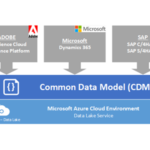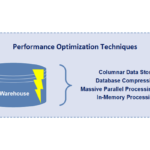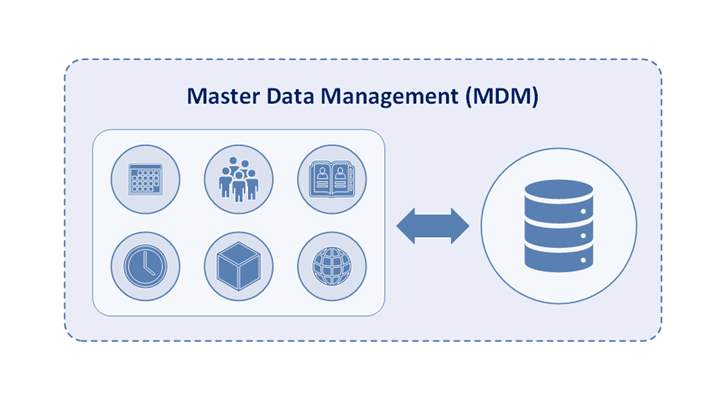
Background
Historically organizations have deployed disparate and isolated computer applications and information systems each with their own sets of independent data. Moreover, each of these applications and systems encapsulates its own and distinctive version of data that could be shared, including data elements related to customers, products, materials, assets, locations, accounts, suppliers, and requests. Many organizations have relied heavily on their information technology departments and time consuming processes to sort out the puzzle of how to synchronize enterprise data among applications and systems and subsequently enable data integration and interoperability.
Further, many organizations have evolved in a manner so that no single enterprise computer application is the central system of record. Each computer application keeps a record of data in a proverbial silo with little or no integration of the controlling and core data elements and fields. Many computer applications have been designed in a manner so that each application only cares about the portion of control data that is related to the transactions that the application needs to process. So at the moment when organizational decision-makers require instant access to high-quality information about fundamental organizational entities, the data is often inconsistent, inaccurate, and difficult to retrieve in a presentable format.
According to the research and advisory firm Tower Group:
• About 50% of organizations maintain master data separately in eleven or more systems.
• Roughly 80% of organizations have plans to centralize their master data.
More and more organizations are facing an ever-increasing problem that makes their organization inefficient and weakens their ability to conduct accurate reporting and analytics. Implementing a comprehensive and thorough master data management (MDM) strategy is imperative for organizations to take control and manage their growth, change their business processes, and evolve and integrate their software applications. As stated by Forrester Research, “Most global 2,000 companies utilize between five and fifteen separate reporting and analysis applications.” This point illustrates the need for organizations to set up and mandate a company-wide set of reporting and analytic structures. A conclusion can be inferred that not having an enterprise upon enterprise master data is similar to a setting up a financial system with having agreed upon chart of account structure. When an organization adopts a comprehensive MDM solution, business users are then able to handle changes to reference data across a wide range of software applications to those analytical applications that affect the entire reporting structure.
Daniel Drucker and Robert Rich in DB2 Magazine, July 2005, state “The lack of a single consistent enterprise system to manage comprehensive master information results in incorrect answers in business intelligence, undermines customer relationship management efforts, and makes it impossible to consolidate spending across suppliers. These complications slow the launch of new products and expose the company to significant regulatory and compliance risk.”
Definition of Master Data Management
Master Data Management (MDM), also known as reference data management, attempts to solve the issue of a having multiple systems of record within an organization. MDM solutions have become a combination of applications, technologies, and processes that consolidate, clean, and augment corporate master data and synchronize it with all applications, business processes, and analytical tools within an organization. This results in significant improvements in operational efficiency, reporting, and fact based decision-making. In addition, master data management includes the practice of defining and maintaining consistent definitions of business entities, then sharing them via integration techniques across multiple computer systems within an organization.
According to Gartner, Inc… Master data is a consistent and uniform set of identifiers and attributes that describe the core entities of the enterprise and are used across multiple business processes.
Additionally the company Profisee defines master data as the core data within the enterprise that describes objects around which business is conducted. It typically changes infrequently and can include reference data that is necessary to operate the business. Master data is not transactional in nature, but it does describe transactions. The critical nouns of a business that master data covers generally fall into four domains and further categorizations within those domains are called subject areas, sub-domains or entity types.
David Butler, Bob Stackowiak in Master Data Management, An Oracle WhitePaper, October, 2006 state that master data management has three architectural components: The technology to profile, consolidate, and synchronize the master data across the enterprise. The applications to manage, cleanse, and enrich the structured and unstructured master data. The industry solution sets to bring the tailored quality master data to the industry specific business process.
To this end, effective master data management solutions include a perpetual an on-going process rather than a onetime system implementation. This process becomes strategic to the organization and spans all enterprise software application, database management systems, and organizational processes. It provides the organization with a fundamental “system of record” that keeps consistent,accurate, and timely core and master data. Thus other systems and process subsequently have the ability to create, retain, and integrate core data elements with the primary “system of record.” Consequently, organizations receive the benefit of being able to more effectively administer changes to their control and core data.
Three Types of Enterprise Data
All business enterprises have three varieties of physical data located within their organization’s information systems. These varieties of data are characterized by their data types and their purpose within the organization. Transactional Data, Analytical Data, & Master Data.
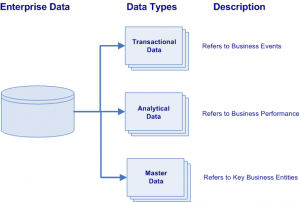 Transactional data is defined as the data that describes a business event (the change as a result of a transaction) and is usually described with verbs. Further, transactional data supports the applications and the operations of an organization. Typically, transactional data are stored within normalized tables within online transaction processing (OLTP) systems and are designed for integrity. Rather than being the objects of a transaction such as customer or product, transactional data is the describing data including time and numeric values. Examples of transactional data include time, price, discount, payment method, & amount.
Transactional data is defined as the data that describes a business event (the change as a result of a transaction) and is usually described with verbs. Further, transactional data supports the applications and the operations of an organization. Typically, transactional data are stored within normalized tables within online transaction processing (OLTP) systems and are designed for integrity. Rather than being the objects of a transaction such as customer or product, transactional data is the describing data including time and numeric values. Examples of transactional data include time, price, discount, payment method, & amount.
Analytical data is defined as the numerical values, metrics, and measurements that support organizational decision making. Moreover, analytical data supports decision-making, reporting, query, and analysis. Typically analytical data is stored in online analytical processing (OLAP) repositories optimized for business intelligence, such as enterprise data warehouses and departmental data marts. Analytical data is characterized as being the facts and numerical values in a dimensional model. Normally, the data resides in fact tables surrounded by key dimensions such as customer, product, account, location, and date/time. However, analytical data are typically defined as the numerical measurements rather than being the describing data.
Master data represents the business entities that are shared across more than one transactional application within an organization. Further, master data represents the business entities upon which transactions are executed and the dimensions around which analysis is conducted. Moreover, master data creates a single version of the truth about the entities across the organization. And master data is typically represented in a dimension model as conformed dimensions that are repeatedly used across subject areas.
Master Data Entities
There are numerous data entities that can be considered master data. Further, the selection of master data entities is unique to every organization and depends somewhat on the nature of the organization. And most organizations will chose to implement multiple master data entities. Master data entities within commercial enterprises typically include customer, product, asset, employee, supplier, and vendor. Master data entities within government organization typically include constituent, citizen, resident, employee, and provider. The choice to identify a data element as a master data entity includes: the number of systems that data entity is included within, the number of business processes that the data entity is included within, the importance of the data entity to the organization, quality of data within the data entity, and agreement on ownership of the data entity.
Typical master data entities that are implemented in master data management (MDM) implementations include:
• Customer
• Product
• Asset
• Employee
• Vendor
• Site
• Location
• Route
Data Management Architecture
For true quality information across an enterprise, the operational and analytical aspects of that particular organization’s master data must work together. Within a perfect data management architecture, the master data management component is tightly integrated with all of the transactional and analytical applications residing within the organization.
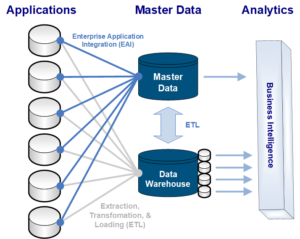 In the ideal application/data architecture, master data is directly linked and connected with all the transactional systems via Enterprise Application Integration (EAI). EAI is commonly referred to as the use of middleware to enable software applications to effectively and seamlessly interoperate in near or close to real-time manner and to create a systematic connection of applications. EAI implementations ensure that the clean master data is synchronized within all of the organization’s transactional applications. This is accomplished by leveraging a full cross-reference for every managed organization entity within in the master data management repository. In addition, clean and accurate attribution for each master data organization entity is maintained in the same master data management repository, and the master data management system can then supply these attributes back to connected transactional systems or integrated business processes.
In the ideal application/data architecture, master data is directly linked and connected with all the transactional systems via Enterprise Application Integration (EAI). EAI is commonly referred to as the use of middleware to enable software applications to effectively and seamlessly interoperate in near or close to real-time manner and to create a systematic connection of applications. EAI implementations ensure that the clean master data is synchronized within all of the organization’s transactional applications. This is accomplished by leveraging a full cross-reference for every managed organization entity within in the master data management repository. In addition, clean and accurate attribution for each master data organization entity is maintained in the same master data management repository, and the master data management system can then supply these attributes back to connected transactional systems or integrated business processes.
Extraction, Transformation, & Loading (ETL) is then used to integrate the master data to either an enterprise data warehouse or departmental data mart within an organization. ETL refers to a bulk data integration processes that includes extracting data from their operational or external data sources,transforming the data into an appropriate format,and loading the data into a data warehouse or data mart repository.
The full cross reference of master data maintained in the master data management system is made available to the data warehouse and data marts via ETL tools. The entities of the master data typically represent and are converted to many of the major and conformed dimensions supported within the datawarehouse. The data warehouse is subsequently able to provide accurate aggregation across the key organizational entities and improved the reporting and analytics come out of the data warehouse and data marts. Also, ETL tools can effectively keep the master data management dimension tables synchronized with the data warehouse fact tables and support join conditions across these two disparate domains.
Benefits of an Master Data Management (MDM) Solution
Fundamentally, master data management is an effective method to provide consistent, comprehensive reference data across an organization. Moreover, the creation of an MDM strategy and implementation of MDM technologies enable organizations to realize internal efficiencies by reducing the cost and complexity of the utilization of master data across the enterprise. In addition, MDM improves an organization’s ability to share, consolidate, and analyze relevant information in a rapid fashion. At its core, MDM ensures that an organization does not use multiple and possibly inconsistent versions of the same master data in different parts of its operations. Subsequently, MDM solutions bring with them several types of business benefits:
• Operational Efficiencies: Improvements in the day-to-day operations of an organization, reducing of unnecessary costs, and streamlining of business processes.
• Reduced Time to Market: Application systems are positioned in amore effective manner to speed the process of conceiving new products and making them available for sale.
• Enhanced Business Intelligence: Increased insight into organizational data, superior visibility into operations assisted in accelerated and more accurate decision-making.
• Ensuring Compliance: Acting in accordance with industry mandates and government regulations such as Sarbanes-Oxley (SOX) helps avoid substantial regulatory fines
• Increased Revenue: A more complete and accurate representation of the customer allows for sales and marking efforts to be more effective.
• Improved System Integration: Information silos within application systems are reduced resulting in reduced integration costs, greater team collaboration, and improved business productivity.
• Greater Data Quality: Organizational data has a higher degree of integrity as it becomes more complete, valid, consist, timely, and accurate.
• Data Governance: Systems of record are identified and deployed that create a consistent,enterprise view of an organization’s data.
• Reduced Dependency on Information Technology (IT) Department: Business users are able to utilize a greater amount of functionality within existing application systems with less support from IT.


